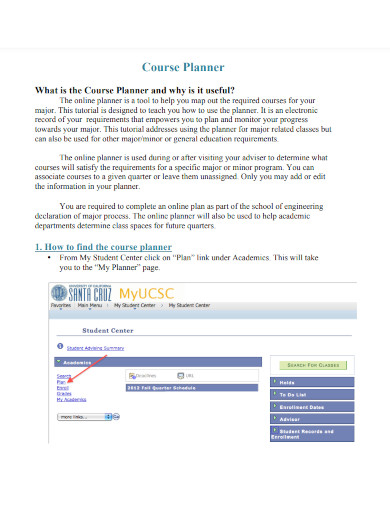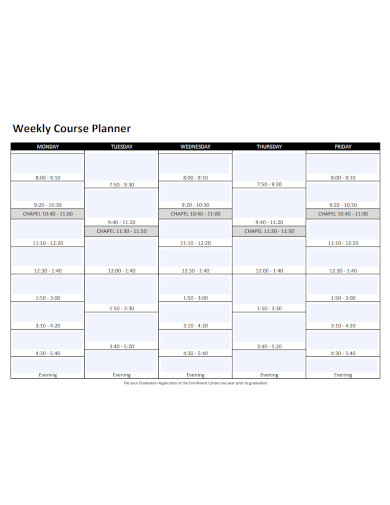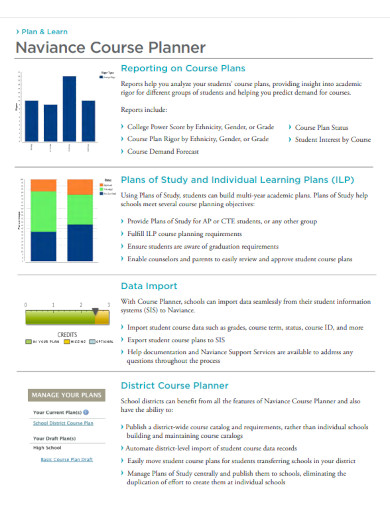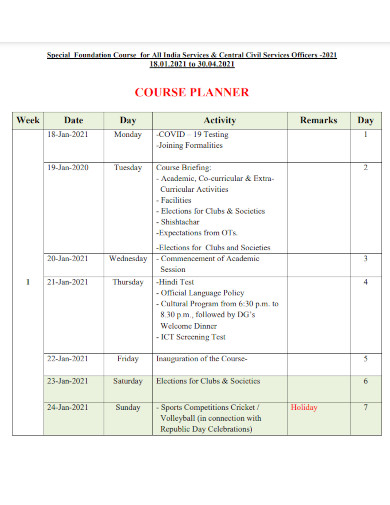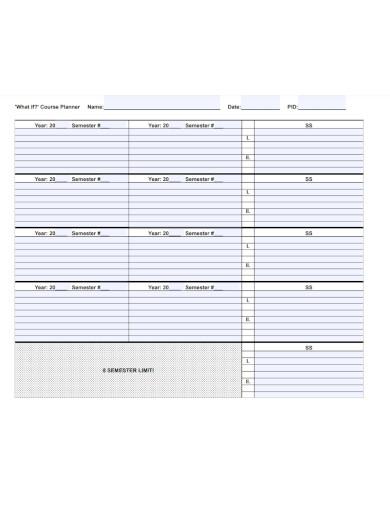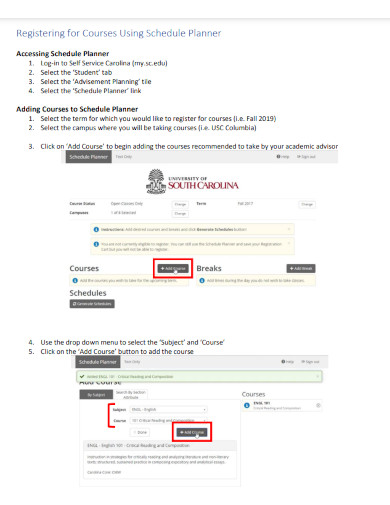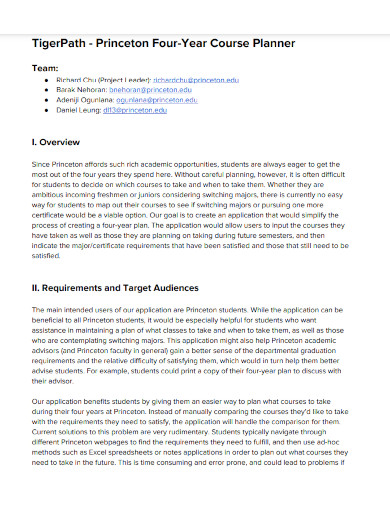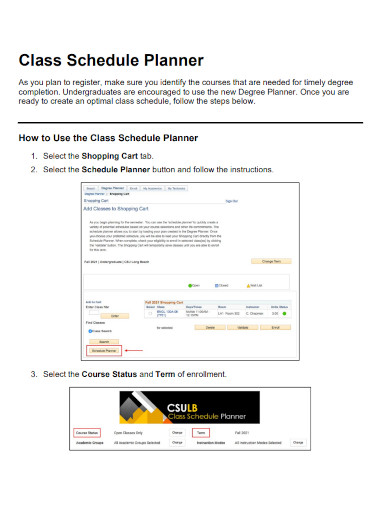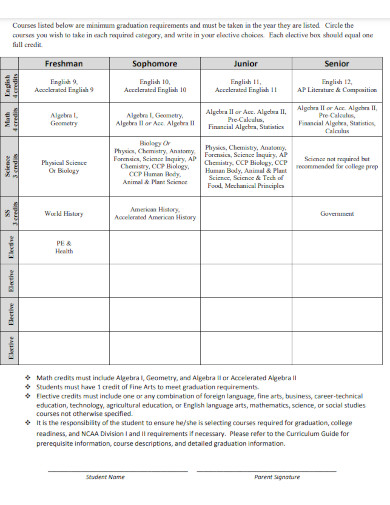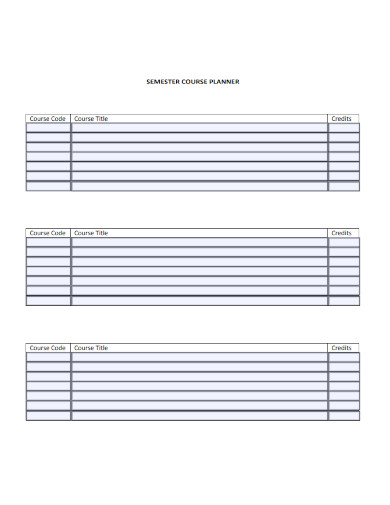Planning their lessons is one of the most essential skills that a teacher or mentor needs to possess. This skill involves the capability to imagine what is going to happen during the lesson and make appropriate choices based on these scenarios. It also includes the ability to know how they can fit a 2-hour lesson into a 100-hour course and how they can work out an activity in 15 minutes. Teachers plan lessons to know what they are trying to achieve at the end of the lesson and produce an educational development plan which will enable a child to understand, learn, and practice their skills.
10+ Course Planner Samples
1. Course Planner Example
2. Weekly Course Planner
3. Naviance Course Planner
4. Sample Course Planner
5. Blank Course Planner
6. Registering for Courses Using Schedule Planner
7. Year Course Planner
8. Class Course Schedule Planner
9. Connections Course Planner
10. Four year Course Planner
11. Semester Course Planner
What is a Course Planner?
Teachers need to plan the lessons they will be teaching their students and students must develop a plan on how they can study more effectively and efficiently. With a course planner, students can understand their course structure and plan which subjects and majors to study to be able to accomplish both their personal goals and student goals. As a student, a course planner shows them how many core and component units they must enroll in and complete for each teaching period.
How to Create a Course Plan?
An academic course plan or outline is a document that can benefit both students and professors. Writing a course plan provides professors with guidance on how the course will develop and guide students by helping them set their course goals and learning objectives. A course outline can also serve as a professional reference for colleagues, administrators, and accreditation offices.
Step 1: Determine the Objectives of the Course
The first step in constructing a course plan is to determine the objectives of the course such as the big ideas and learning activities it will be covering, the important understandings that students will be able to take away from the course, and more. As a teacher, this will determine what you can expect from your students and what they can expect from the lesson.
Step 2: Determine the Student Learning Objectives
Determining the outcome is crucial in designing your course and an essential element to include in your outline. An outcome refers to a statement that is verb-oriented and directed to the students who are taking the course.
Step 3: Provide an Assessment Overview and Plan
The assessment overview is the grading scale that will be used as a guide that enables your students to see the value or percentage applied to different assessment elements of your course like quizzes, journal assignments, participation, team assignments, and final exam. While your assessment plan is established based on the learning objectives you determined for your students.
Step 4: Include a Schedule for Each Activity
After planning your course outline, you can now set schedules for your activities. Once you have determined which method to use to assess your students, create activities that will help you in facilitating the learning process that needs to be completed to enable your students to achieve their learning goals. These activities can include lectures, readings, small groups, and large group discussions.
FAQs
What are the benefits of lesson planning or outlining?
With lesson plans, you can set course goals, establish student learning outcomes, create and align performance evaluation plans, and create a schedule for the course. You can also guide your students by providing an outline of their goals, materials, timelines, and learning objectives.
Why do I have to map my course?
By mapping your course, you can establish manageable units of learning, determine which assessment is most effective and matches your learning outcomes, provide clear expectations for your students, create a goal roadmap of the course, and more.
What can be included in a course table of contents?
The table of contents for your course plan may include the course goals, course learning outcomes, materials or equipment to be used, course schedule, course format or style, assessment, and course evaluation.
A course plan is an important element when designing a course and provides assistance in communicating the core values and goals of the course that the students are going to learn. It provides an outline of the course outcomes, schedules, readings, assignments, and details on how the course will be taught and assessed.
Related Posts
FREE 10+ Meeting Planner Samples in PDF
FREE 8+ Calendar Planner Samples in PDF
FREE 10+ Cute Workout Planner Samples in PDF | MS Word | Apple Pages
FREE 10+ Financial Planner Samples in PDF | MS Word | Apple Pages
FREE 10+ Digital Planner Samples in PDF | Apple Pages | MS Word
FREE 7+ Year Life Plan Samples in PDF
FREE 6+ 7 Day Weekly Planner Samples in PDF
FREE 50+ Project Planner Samples in PDF | MS Word
FREE 50+ Planner Samples in PDF | MS Word
FREE 10+ Menu Planner Samples in PDF
FREE 10+ Training Planner Samples in PDF
FREE 6+ Bill Planner Samples in PDF
FREE 8+ Birthday Planner Samples in PDF
FREE 10+ Yearly Planner Samples in PDF | MS Word | Apple Pages
FREE 3+ Covid Birth Plan Samples in PDF

